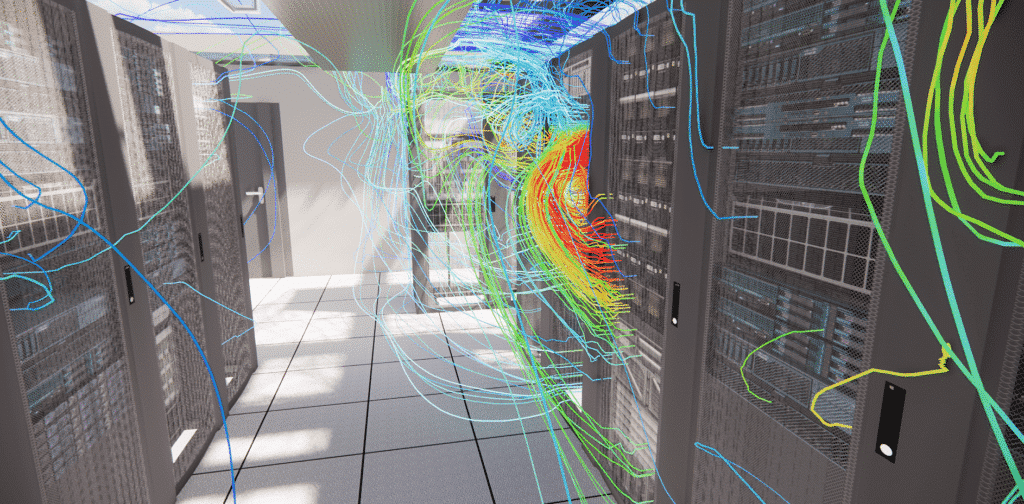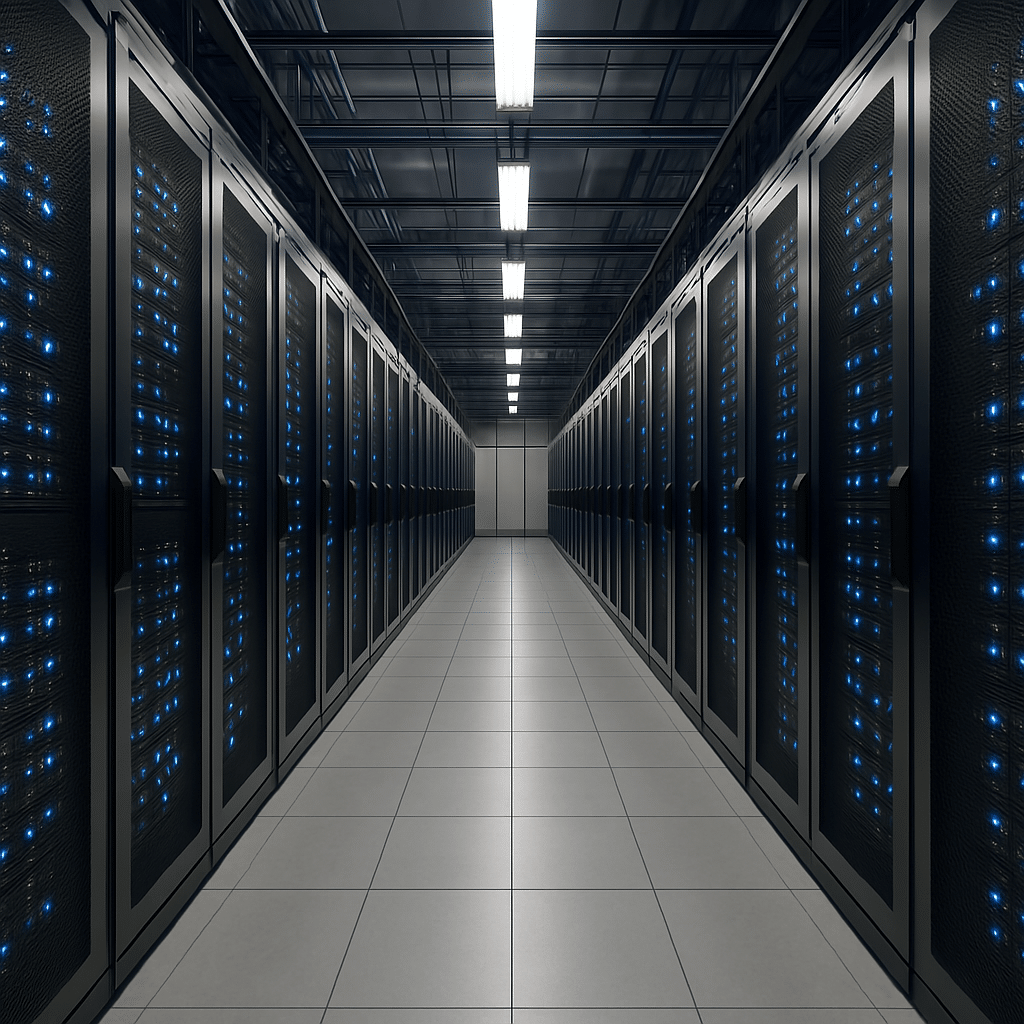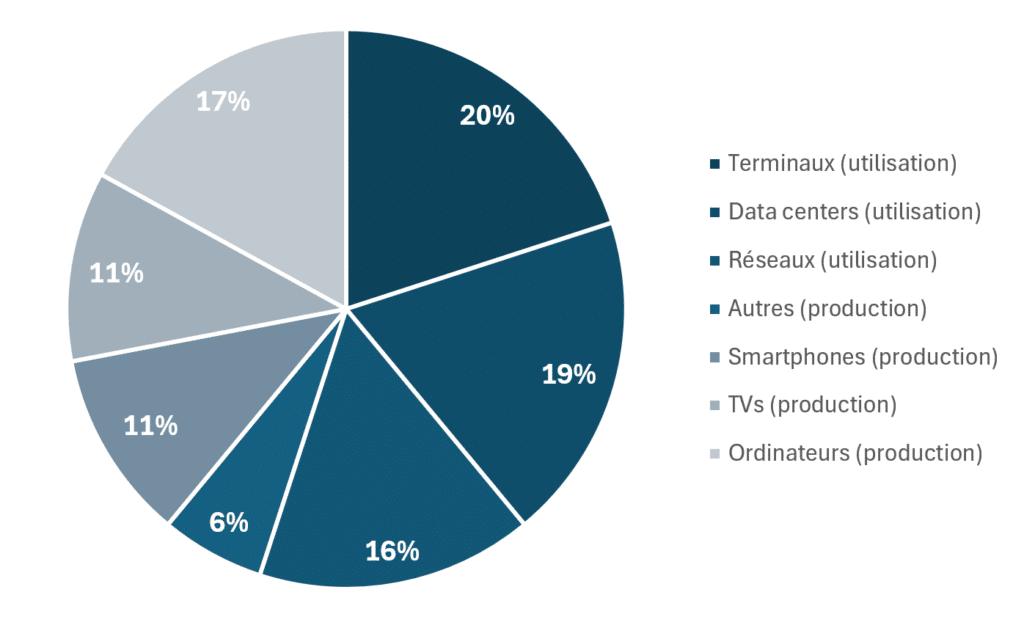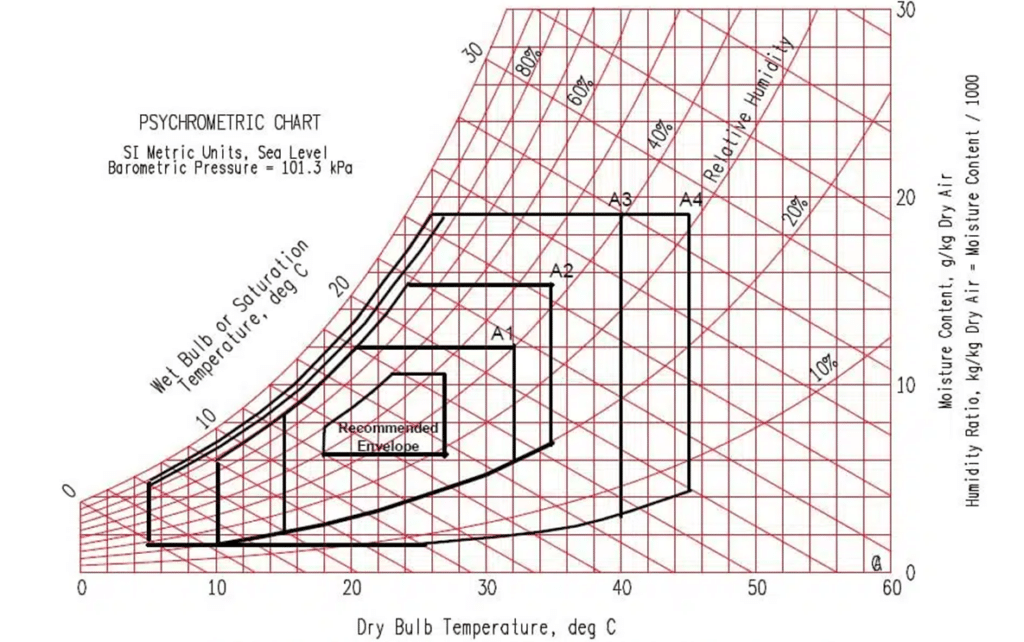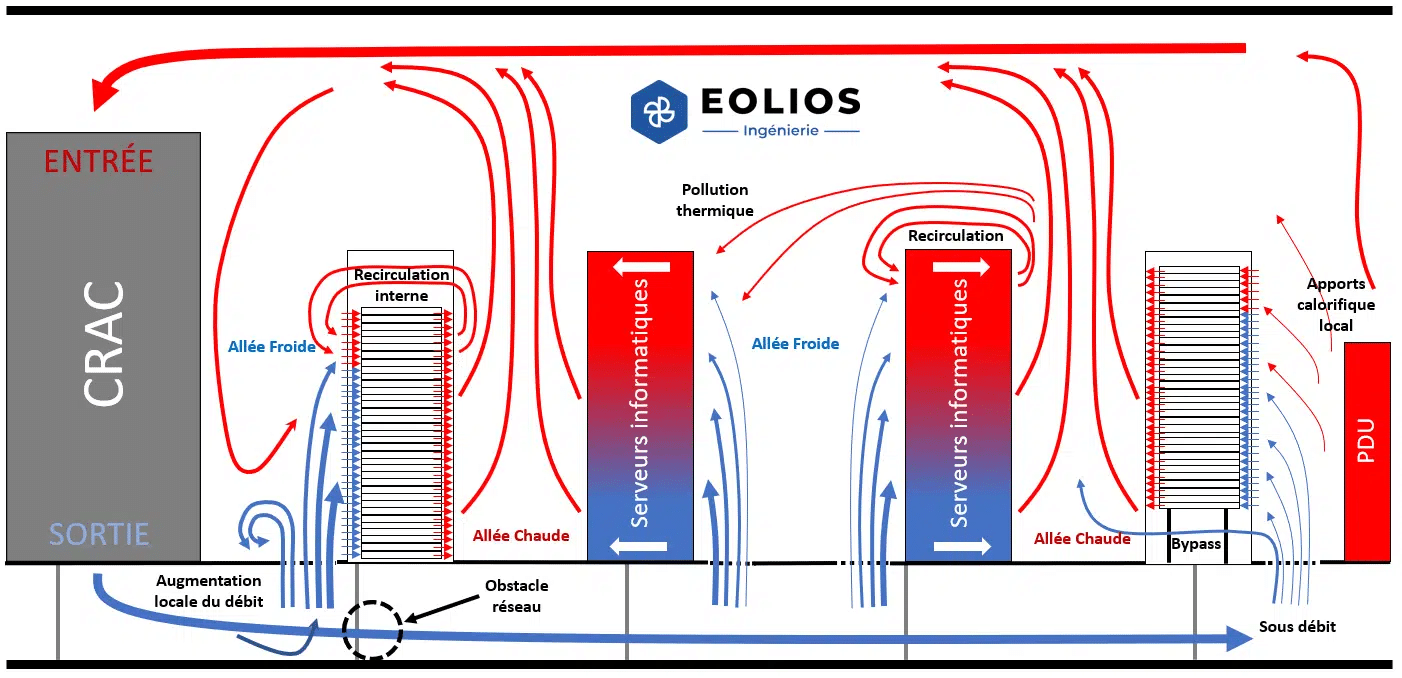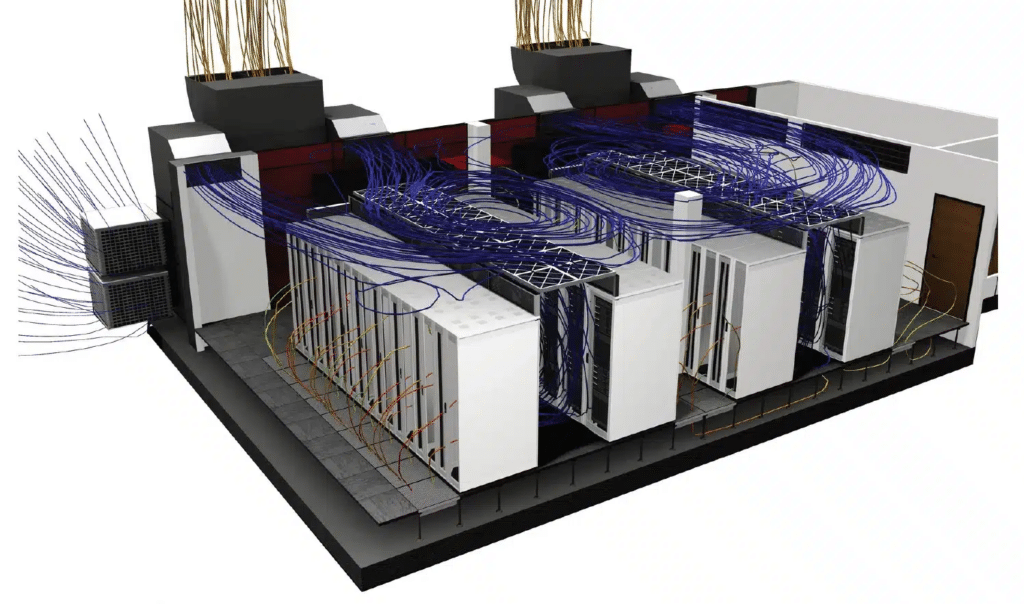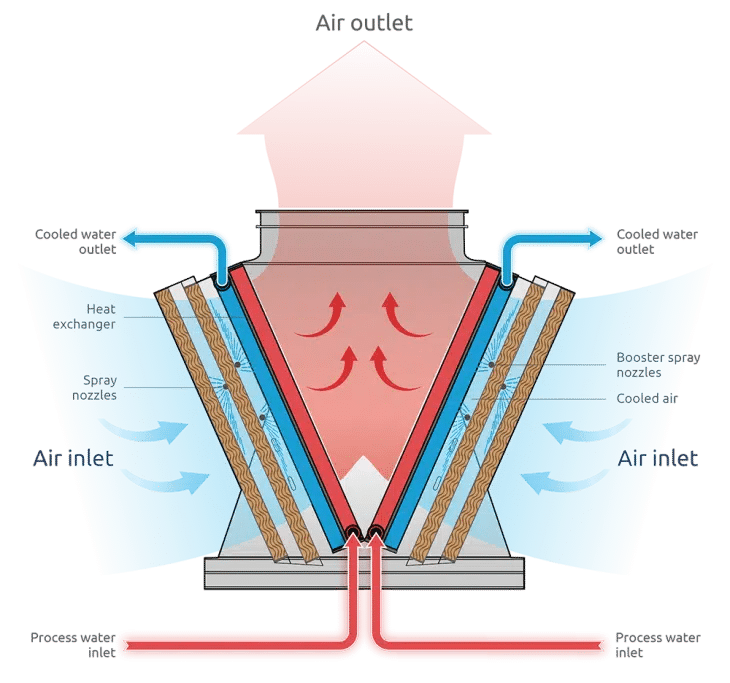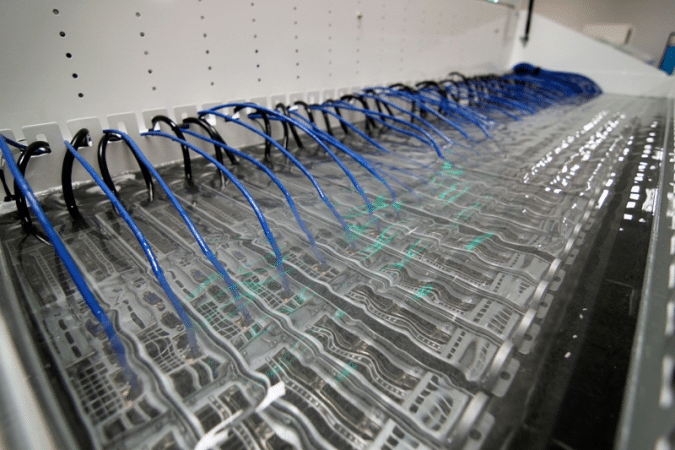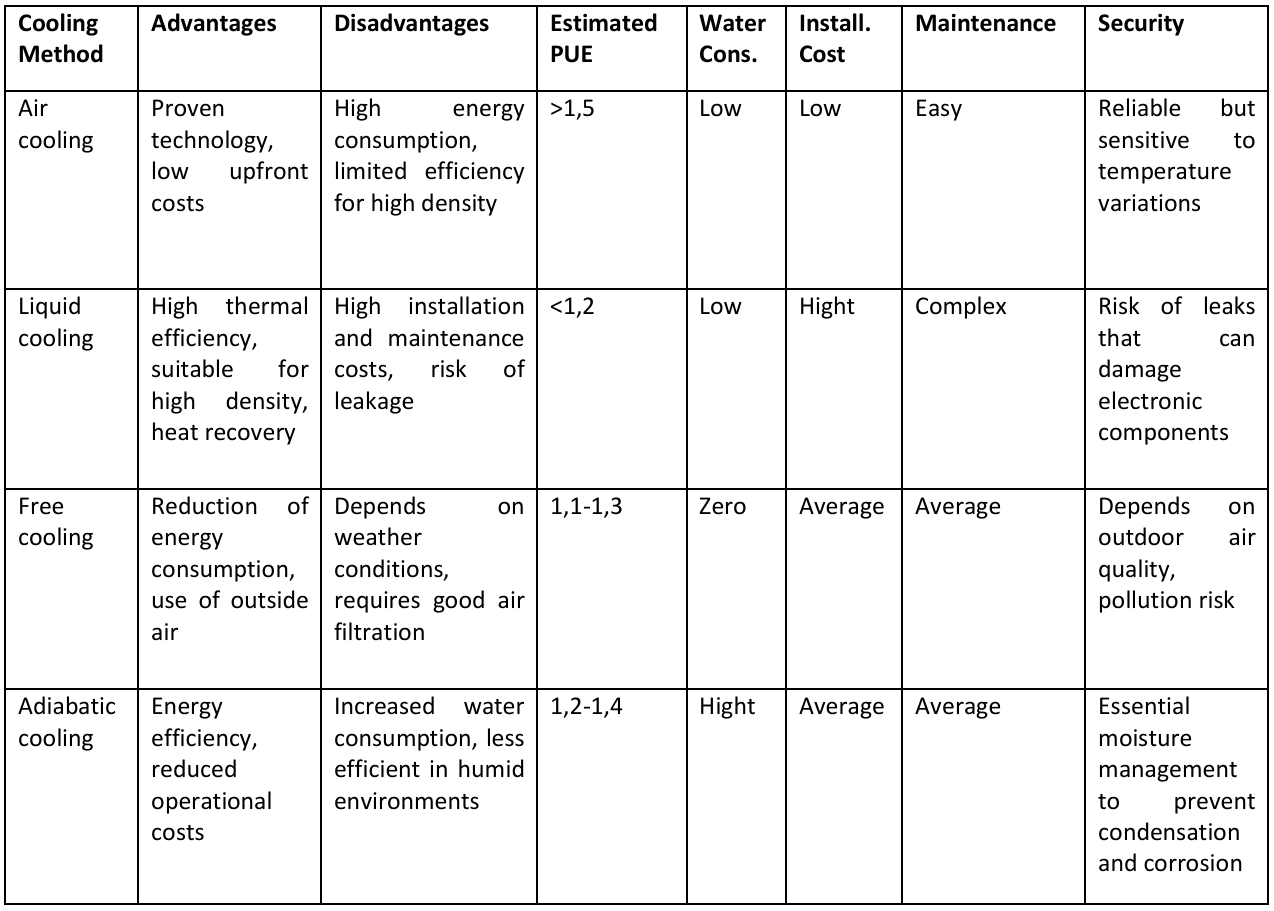Data center cooling systems
Accueil » Data Center » Data center cooling systems
Data Center - Cooling methods
The cooling of data centers is a strategic issue, directly influencing their energy efficiency, reliability and environmental impact. Optimized thermal managementprevents IT equipment from overheating, reduces energy consumption and minimizes the risk of downtime.
Asexperts in fluid mechanics, we understand the complex challenges associated with heat dissipation in digital infrastructures. Thanks to an integrated approach combining CFD simulation, energy analysis and heat flow optimization, we support data center operators in implementing efficient and sustainable cooling solutions, adapted to today’s performance and thermal safety requirements.
- Data center audits and diagnostics
- CFD engineering for data centers
- Thermal study of technical premises
- Generators
- Designing your data center’s digital twin
- Urban heat island impact study for data centers
- External CFD simulation for data center
- Energy optimization and PUE calculation for data centers
- Data Center Fire Simulation
- Data center audits and diagnostics
- CFD engineering for data centers
- Thermal study of technical premises
- Generators
- Designing your data center’s digital twin
- Urban heat island impact study for data centers
- External CFD simulation for data center
- Energy optimization and PUE calculation for data centers
- Data Center Fire Simulation
Our Data Center projects :
The problem of cooling data centers
Heat generation by IT equipment
Data centers are essential infrastructures in the digital world, housing a multitude of servers and IT equipment in continuous operation. This incessant activity generates a significant amount of heat.
In fact, every electronic component– whether processors, memory modules orstorage units– generates heat during operation. This heat is the result of the energy losses inherent in computing and data processing.
Power density in modern data centers can reach several kilowatts per square meter, resulting in high thermal output. According to one study, data centers consume up to 50 times more energy per unit area than a standard commercial building. In 2017, their consumption accounted for 19% of global consumption in the digital sector. This energy consumption translates directly into proportional heat emissions.
The consequences of poor thermal management
Inadequate thermal management in a data center can have major repercussions on equipment and theoverall infrastructure. The main consequences include :
-
Overheating of electronic components: Excessive temperatures can lead to malfunctions, calculation errors and, ultimately, hardware failure. Electronic components are designed to operate within a specific temperature range; exceeding these limits reduces their reliability and performance.
-
Increased energy consumption: Cooling systems have to compensate for any uncontrolled rise in temperature, which increases their workload and, consequently, energy consumption. It is estimated that cooling systems account for almost 40% of a data center‘s total energy consumption.
-
Reduced equipment life: Prolonged exposure to high temperatures accelerates the ageing of electronic components, shortening their operational life and increasing replacement and maintenance costs.
-
Increased operational costs: In addition to additional energy costs, poor thermal management can lead to costs associated with downtime, unscheduled repairs and the need to invest in more efficient cooling solutions.
The objectives of an efficient cooling system
To ensure the smooth running of data centers and optimize their performance, an efficient cooling system must meet the following objectives:
-
Maintaining a stable, even temperature: Maintaining an optimum ambient temperature, generally between 18 and 27°C, is crucial for equipment to function properly. Uniform temperature distribution prevents hot spots that can lead to malfunctions.
-
Optimizing energy efficiency: Reducing the energy consumption of cooling systems is essential to lowering the data center‘s operating costs and carbon footprint. The adoption of advanced cooling technologies, such as free cooling or liquid cooling, can contribute to this optimization.
-
Reducing the environmental footprint: By minimizing the use of natural resources such as water and energy, data centers can reduce their environmental impact. For example, recovering and using excess heat to heat adjacent buildings is a sustainable approach.
Thermal management of data centers is therefore a crucial issue, directly influencing their performance, sustainability and environmental impact.
Appropriate, efficient cooling systems are essential to meet the challenges posed by the increasing energy density of digital infrastructures.
Data center cooling fundamentals
The need for appropriate cooling
Data centers are essential infrastructures for storing and processing digital data. Their continuous operation generates a significant amount of heat, mainly due to the high density of IT equipment. Effective thermal management is therefore crucial to ensure the performance, reliability and longevity of this equipment.
Heat transfer mechanisms: conduction, convection and radiation
Heat dissipation in a data center is based on three fundamental mechanisms:
-
Conduction: This process involves the transfer of heat through solid materials, such as electronic components and the physical structures of servers. Heat spreads from high-temperature areas to lower-temperature ones by direct contact.
-
Convection: This mechanism involves the movement of heat via fluids, usually air, which circulate around equipment. In a data center, thehot air generated by servers is evacuated and replaced bycooler air, facilitating the cooling of components.
-
Radiation: Hot equipment surfaces emitthermal energy in the form of infrared radiation. Although this transfer mode is less predominant than conduction and convection, it nevertheless contributes to overall heat dissipation.
Air flow organization: separation of hot and cold aisles
A common strategy for optimizing cooling in data centers is toorganize them into hot and cold aisles. This configuration aims to separate hot and cold air flows to prevent them from mixing, thus improving theefficiency of the cooling system.
-
Cold aisles: These consist of the fronts of server racks, where fresh air is blown in to cool the equipment.
-
Hot aisles: located at the rear of the racks, they collect the hot air expelled by the servers after cooling.
Hot aisle / Cold aisle confined data center
By alternating these aisles and confining them with physical barriers or containment systems, we limit the mixing of air flows. This organization helps maintain lower temperatures atserver entrances and reduces the load on air-conditioning systems. In addition, theuse of raised floors with perforated slabs can facilitate the uniform distribution of cool air in cold aisles.
Recommended temperatures and humidity in the data hall
Maintaining appropriate environmental conditions is essential to ensure the proper operation and durability of IT equipment. TheAmerican Society of Heating, Refrigerating and Air-Conditioning Engineers (ASHRAE ) provides specific guidelines in this respect.
-
Temperature:ASHRAE recommends a temperature range of between 18°C and 27°C for class A1 to A4 equipment. This range is designed to balance energy efficiency and equipment reliability.
-
Relative humidity: Too low a humidity can lead to electrostatic discharge, while too high a humidity can cause condensation and corrode components.ASHRAE suggests maintaining relative humidity between 20% and 80%, with a maximum dew point of 22°C.
It’s important to note that these recommendations may vary according to equipment specificities and operational requirements. Consequently, continuous monitoring of environmental conditions, using sensors and management systems, is essential to rapidly detect and correct any drift.
Understanding the fundamentals of heat transfer,strategically organizing air flows and maintaining optimal environmental conditions are key elements in guaranteeing theenergy efficiency and reliability of data centers.
Computer room cooling systems
Air conditioning by CRAC and CRAH units
CRAC(Computer Room Air Conditioner) and CRAH(Computer Room Air Handler) units are commonly used to cool data centers.
-
CRAC units: These systems operate in a similar way to domestic air conditioners. They use a compressor and a refrigerant to cool the ambient air.Warm air is drawn in, cooled by passing over a coil containing the refrigerant, then redistributed into the computer room. CRAC units are generally self-contained and do not require complex external connections. They are particularly suited to small to medium-sized data centers, with IT loads of less than 200 kW.
-
CRAH units: Unlike CRACs, CRAH units do not use a compressor. They are equipped with fans and coils cooled by chilled water from an external production system.Warm air is drawn in, passed over the cooled coils, then returned to the room at a lower temperature. CRAH units are more energy-efficient, as they operate a centralized cooling system. They are suitable for larger data centers, with IT loads in excess of 200 kW.
Raised floors and flow management
Theuse of raised floors is a common practice in data center design to optimize air circulation and improve cooling efficiency.
These floors are made up of modular slabs laid on a metal structure, creating an empty space between the original floor and the floor. This space, known as the plenum, serves as a duct for the distribution of cooled air.
In terms of airflow management,cold air is routed under the raised floor and distributed to the cold aisles via perforated tiles or grilles. IT equipment draws in this cool air to cool its internal components, then discharges the warm air into the hot aisles. The hot air is then captured by CRAC or CRAH units for further cooling. This separation between hot and cold aisles minimizes mixing of air flows, thus improving theenergy efficiency of the cooling system.
Data center cooling and heat dissipation circuits
Chillers and chilled water systems
Chillers and chilled water systems play a central role in data center cooling, especially for large-scale installations.
-
Chillers: These thermodynamic devices producechilled water using a refrigerant compression and expansion cycle. Thewater is cooled to a temperature generally between 6°C and 12°C, then conveyed to air handling units (AHUs ) or other heat exchangers to lower the ambient air temperature. Chillers can be fitted with free-cooling systems, enablingoutdoor air to be used when climatic conditions are favorable, thus reducing energy consumption.
-
Chilled water systems: In this type of system, thechilled water produced by the chillers circulates through a network of pipes to supply the CRAH units or in-row air conditioners (InRow). The latter are installed in close proximity to the server racks, enabling targeted, efficient cooling. After absorbing heat from the equipment, thewater returns to the chillers to be cooled again. This closed loop ensures continuous, controlled heat dissipation.
These conventional cooling systems are essential for maintaining optimum thermal conditions in data centers. Their choice and implementation depend on a number of factors, such as facility size, power density, budget constraints and energy efficiency objectives.
Free cooling: using outside air and heat exchangers
Free cooling exploits outdoor climatic conditions to cool data centers, reducing dependence on traditional mechanical cooling systems. This approach can be implemented in two ways:
-
Direct free cooling: when theoutside air is cool enough, it is filtered to remove unwanted particles and injected directly into the server rooms. This method is effective when the outside temperature is lower than the desired inside temperature, generally around 25°C. However, it requires rigorous monitoring of air quality and humidity to avoid any negative impact on equipment.
-
Indirect free cooling: In this configuration,outside air cools an intermediate fluid (such aswater) via a heat exchanger. This fluid then circulates inside the data center to absorb heat from the equipment, without theoutside air coming into direct contact with theinternal environment. This method offers better control of humidity and air quality, while benefiting from the energy advantages of free cooling.
Theeffectiveness of free cooling is highly dependent on local climatic conditions. In regions with cold winters, this technique can cover a large proportion of cooling requirements, whereas in warmer climates, its use will be more limited.
Adiabatic cooling and evaporation
Adiabatic cooling is based on the principle of water evaporation, which absorbs heat from theambient air, reducing its temperature. In a data center, this technique is implemented byhumidifying incoming air, or through adiabatic heat exchangers, wherewater evaporation cools a circulating fluid.
This process is particularly effective in dry climates, where theair has a high moisture absorption capacity, optimizing cooling.
By reducing dependence on chillers and mechanical air-conditioning systems, it cuts energy consumption andimproves the data center‘sPUE(Power Usage Effectiveness).
However, its effectiveness diminishes whenambient humidity is high, limiting its usefulness in certain regions.
One of the main challenges of adiabatic cooling is humidity management. Excessive humidity in the air can lead to condensation, affecting IT equipment and increasing the risk of corrosion of electronic components. Precise humidity control is therefore essential to avoid thermal imbalance.
Another aspect to consider is water consumption, which can be significant depending on the system configuration. This increased use of water raises environmental and regulatory issues, notably in relation to ICPE(Installations Classées pour la Protection de l’Environnement) and TAR(Taxe sur les Activités Polluantes liées aux Rejets d’Eau). These constraints call for rigorous management of discharges and water treatment, as well as compliance with local regulations, making adiabatic cooling suitable only under certain well-controlled conditions.
Advanced solutions and innovations for data center cooling
Hybrid cooling: air/water combination
Hybrid cooling systems combine the advantages of free cooling and mechanical cooling systems to optimize energy efficiency. For example, a hybrid system can use free cooling when outdoor conditions are favorable, and switch to mechanical cooling when the outdoor temperature rises. This flexibility reduces energy consumption while ensuring a stable temperature inside the data center.
Another example of a hybrid system is theuse of adiabatic chillers combined with mechanical cooling units. In this case, theair is first cooled by evaporation, then a mechanical system adjusts the temperature to achieve the desired levels. This approach reduces the load on mechanical systems, extending their service life and cutting operating costs.
Liquid cooling: immersion and direct contact
With theincreasing power density of IT equipment, air cooling is reaching its limits in terms of efficiency. Liquid cooling offers an alternative, using fluids to absorb heat directly from components. Two main methods are employed:
- Immersion cooling: Servers or components are immersed in a non-conductive dielectric liquid. This liquid absorbs the heat generated, which is then dissipated via heat exchangers. This method eliminates the need for fans, and considerably reduces cooling-related noise and energy consumption. It also allows higher power density, optimizing available space.
-
Direct-to-chip cooling: cold plates are installed directly on critical components, such as processors. A fluid circulates through these plates, absorbing heat and transporting it to a heat exchanger. This approach offers precise temperature control of key components, and can be integrated into existing infrastructures with minimal modifications.
Liquid cooling offers significant advantages in terms ofthermal efficiency and reduced energy consumption. However, it requires higher initial investments and specialized maintenance to manage fluids and ensure system tightness.
On-chip cooling and emerging technologies
Direct-to-chip cooling is an advanced technique in which microchannels are integrated directly into chips or processor modules. A cooling fluid circulates through these microchannels, absorbing heat at the very source of its generation. This method offers extremely efficient heat dissipation, essential for high-performance applications such as intensive computing or servers dedicated to artificial intelligence.
Emerging technologies also include two-phase cooling systems, where the coolant changes state as it absorbs heat, offering superior heat dissipation capacity. Research is also underway to develop phase-change materials and nanofluids.
Comparative analysis of cooling methods
Choosing the best cooling method
Theenergy efficiency andenvironmental impact of data centers depend largely on the cooling systems used. This section analyzes different cooling methods according to criteria such as Power Usage Effectiveness (PUE), energy consumption,ecological footprint, technical constraints, associated costs and security.
Safety and reliability of cooling systems
Safety warning :
Safety is a fundamental criterion in data center management, where any breakdown, overheating or failure can lead to costly service interruptions and jeopardize data integrity. The choice of cooling system must therefore guarantee equipment reliability and limit the risks associated with thermal malfunctions.
One of the major risks is component overheating, which can lead to premature equipment degradation and unexpected downtime. Excessive temperature can bringa server to a standstill or, in the worst case, irreversibly damage sensitive parts such as processors or storage units. To avoid such incidents, cooling systems need to be designed with redundancy mechanisms, enabling any failure to be remedied by activating an emergency circuit.
In addition to thermal management, the risks associated with liquid leaks must be taken into account, particularly in liquid cooling systems. Theintroduction of heat transfer fluids close to electronic components requires rigorous monitoring and appropriate infrastructures to avoid accidents. Leakage sensors and containment systems are often integrated to detect any anomalies andprevent liquid from damaging sensitive equipment.
Simulation of temperature rise - fire detection study
Risk comparison :
Air-based cooling methods, while less energy-efficient, present a lower safety risk. Theyavoid direct exposure of servers to liquids, and reduce the risk of accidents due to mechanical failure. However, they do require regular maintenance of filters and ventilation systems to preventdust build-up and ensure optimum air circulation.
Finally, emerging technologies such as adiabatic cooling and free cooling need to be assessed in terms of their impact on overall data center safety.Increased humidity levels due to evaporative cooling can pose condensation risks, which need to be managed through hygrometric control devices. Similarly, theuse of outside air for free cooling calls for increased monitoring of air quality to avoid the infiltration of particles and pollutants that could damage internal components.
Energy performance criteria
Power Usage Effectiveness (PUE) is themain indicator for measuring theenergy efficiency of a data center. It is calculated by dividing the data center’s total energy consumption by that used solely by IT equipment. A PUE of 1.0 indicates optimum efficiency, where all energy is dedicated to IT equipment. In France, the average PUE is 1.36, which means that a significant proportion of energy is consumed by auxiliary systems, notably cooling.
Different cooling methods have a direct impact on PUE:
-
Air cooling: Traditionally used, this can result in a higher PUE due to the energy consumption of air conditioners and fans.
-
Liquid cooling: This method enables more efficient heat dissipation, reducing the need for energy-hungry air-conditioning systems. Studies show that theintroduction of liquid cooling can improve PUE by over 15%.
-
Free cooling: By usingoutside air when climatic conditions allow, this technique considerably reduces cooling-related energy consumption, thus improving PUE.
Environmental impact
Theecological footprint of data centers is strongly influenced by their energy andwater consumption. Cooling systems play a crucial role in this respect:
-
Energy consumption: Traditional air-cooling systems consume a lot of energy, contributing to a higher carbon footprint. Conversely, solutions such as liquid cooling or free cooling consume less energy, reducing greenhouse gas emissions.
-
Water consumption: Some techniques, such as adiabatic cooling, use water to cool the air. Although this method is energy-efficient, it increases water consumption, which can be problematic in regions where this resource is limited.
-
Heat recycling: Some installations recover the heat generated to heat adjacent buildings, improving overall energy efficiency and reducing the environmental footprint.
Illustration of thermal plumes in several data center buildings, during a heatwave, and during an emergency restart of generator-type systems.
Technical constraints and limitations
A strategic choice influenced by several factors:
Each cooling method used in data centers has specific advantages, but also technical constraints and limitations that must be taken into account before implementation. The choice of system depends on many factors, including data center configuration, local climatic conditions, installation and operating costs, and energy efficiency requirements.
Air cooling, a proven but energy-hungry solution:
Air cooling, historically the most widespread method, relies on theuse of air conditioners or forced-air circulation systems to evacuate the heat generated by servers. Its main advantage lies in its reliability and accessibility, since it’s a tried-and-tested technology, widely deployed and relatively simple to install. What’s more, initial installation costs are moderate, making it an attractive solution for small and medium-sized infrastructures.
However, this approach has significant limitations, not least reduced thermal efficiency when it comes to cooling high-density equipment. The greater the IT load, the greater the demand on the air-cooling system, resulting in a significant increase in energy consumption. This dependence on mechanical ventilation and air-conditioning systems has a direct impact on thecarbon footprint and operating costs of data centers.
Liquid cooling ,optimal thermal efficiency, but high cost:
Faced with these limitations, liquid cooling is emerging as a more efficient alternative, particularly for computationally-dense infrastructures. This process, which uses a heat transfer fluid to absorb heat directly at the components, offers far greater thermal efficiency than air cooling. It not onlyimproves heat dissipation, but also reduces overall energy consumption, since the circulation of thermally conductive liquids is more efficient thanair at transferring heat.
What’s more, some facilities exploit this waste heat to power other systems, such as district heating, thus optimizing the energy efficiency of the entireinfrastructure.
However, this technology also presents significant challenges. Installation costs are considerably higher, due to the specific infrastructures required for fluid circulation and management. In addition, the maintenance of these systems is more complex than that of air solutions, and the risks of liquid leaks must be rigorously controlled to avoid damage to sensitive electronic equipment.
Free cooling, dependent on climatic conditions:
Free cooling is an interesting solution for reducing energy consumption linked to cooling, by directly exploiting outside air when climatic conditions allow. This system reduces the need for energy-intensive mechanical devices, resulting in improved Power Usage Effectiveness (PUE) and lower operating costs.
However, its effectiveness is closely linked to the climatic characteristics of the data center‘s location. In regions where outside temperatures are too high for most of the year,the contribution of free cooling is limited, necessitating theintegration of other cooling systems to guarantee continuity of service.
What’s more, this process requires theinstallation of advanced filtration systems to prevent particles and contaminants from entering computer rooms, which can complicate implementation.
Adiabatic cooling: water consumption to be monitored :
Finally, adiabatic cooling represents an alternative that combines energy efficiency and reduced operating costs. Based on theevaporation of water to cool the ambient air, this system offers interesting performances, particularly in dry environments where thecooling effect is optimized.
Its main advantage lies in its low energy consumption, making it an attractive solution for reducing the carbon footprint of data centers.
Nevertheless, this technology relies on theuse of water, which raises questions in terms of water resource management, particularly in regions subject to water restrictions.
What’s more, its effectiveness diminishes whenambient humidity is too high, which limits its deployment in certain geographical areas.
Comparison table
The following table summarizes the main characteristics of the different cooling methods :
In short, each cooling method presents a balance between performance, cost and operational constraints. The choice of the optimum solution depends on the data center‘s specific needs, environmental conditions and objectives in terms of sustainability andenergy efficiency.
Optimizing data center cooling with EOLIOS
A global approach to optimized data center cooling
Optimizing cooling systems is a key issue for modern data centers, whereenergy efficiency and thermal management directly influence operating costs, infrastructure sustainability andenvironmental impact.
Toimprove plantperformance, EOLIOS supports industry players with an integrated approach based on advanced numerical simulation tools such as CFD (Computational Fluid Dynamics).
This technologyanalyzes andoptimizes heat dissipationinside computer rooms, as well asheat dissipation to the outside, ensuring more efficient and safer cooling.
Reducing energy consumption by optimizing heat flows
One of the key levers for improving theenergy efficiency of data centers lies inoptimizing air and heatflowsinside IT rooms. Poor airflow management can lead to hot spots, requiring excessive energy consumption to compensate for thermal imbalances.
EOLIOS intervenes by carrying out in-house CFD studies, enabling precise mapping of air circulation andidentification of cooling systeminefficiencies.
Thanks to these analyses, several actions can be implemented:
-
Optimization of hot and cold aisles to limit hot air recirculation and improve cooling distribution.
-
Improving the layout of CRAC and CRAH units in line with actual IT equipment requirements.
-
Identification of hot spots and recommendations for their mitigation through improved airflow management.
-
Integration of air containment solutions, such as physical separators between hot and cold aisles, or perforated floors for improved cooling distribution.
These actions significantly reduce the power consumption of air-conditioning systems, maximizing cooling efficiency while limiting the thermal overload of IT equipment.
Internal heat dissipation via CFD simulation
In a data center, the heat released by servers must be efficiently evacuated to maintain a stable temperature and avoid the risk of breakdowns.
EOLIOS carries out in-house CFD simulations, enabling detailed visualization of heat flows and thermal gradients within computer rooms.
These analyses provide an in-depth understanding of the thermal behavior of infrastructures, and enable several key aspects to beoptimized:
-
Reduced recirculation of hot air, which has a negative impact oncooling efficiency.
-
Validation and optimization of cooling systems, by virtually testing different scenarios before implementation.
-
Improved performance of air handling units, by adjusting their configuration for more even heat dissipation.
Theuse of CFD simulations guarantees decision-making based on accurate, reliable data, helping to reduce energy costs while improving the reliability and security of IT infrastructures.
External heat dissipation and environmental impact
Theevacuation of heat generated by data centers is not limited to the internal management of IT rooms. Once the heat has been extracted from the IT equipment, it must be efficiently dissipated to theoutside, to avoid any thermal build-up that couldaffect the performance of cooling systems.
EOLIOS performs external CFD simulations tooptimize the heat dissipation of the infrastructure, taking into account several environmental factors:
-
Study of thermal discharges to the outside environment, to avoid heat build-up around buildings.
-
Optimization of heat exchanger and chiller locations toimprove heat dispersion and limit impact on ventilation systems.
-
Analysis of outside air flows to minimize recirculation effects and maximize the efficiency of passive cooling systems such as free cooling.
By integrating these CFD analyses into the design andoperation of data centers, it is possible to reduce the environmental impact of facilities while improving their overall thermal efficiency.
Secure infrastructures with advanced thermal management
Beyond simply improving energy efficiency, thermal safety is a major issue in data centers. Inefficient cooling management can lead to downtime, data loss and costly service interruptions.
EOLIOS incorporates thermal safety as a key parameter in its CFD studies, enabling it toanticipate and prevent risks associated with cooling system malfunctions. Precise simulations make it possible to :
-
Identify potential points of failure linked to temperature variations.
-
Evaluate the impact of a cooling systemmalfunction, to implement appropriate redundancy solutions.
-
Optimize airflow management in the event of a partial failure, toavoid rapid temperature rise in equipment.
These analyses give data center operators a predictive view of thermal risks, enabling them to implement proactive management strategies to ensure service continuity and protect critical equipment.
Towards more efficient, sustainable data centers
Thanks to an approach combining energy analysis, internal and external CFD simulation, and safety optimization, EOLIOS helps industry players to find more efficient and sustainable cooling solutions.
By integrating these advanced engineering tools right from the design stage or during the operating phase, it is possible to :
-
Reduce energy consumption and improve infrastructure PUE.
-
Optimize the layout of cooling equipment to maximize efficiency.
-
Limit the environmental impact of thermal waste by controlling heat dissipation.
-
Enhance plant safety by anticipating thermal failures.
Thermal optimization of data centers is no longer limited to a simple technological choice. Thanks to CFD studies andEOLIOS expertise, operators can transform their thermal management into a lever for efficiency and performance, guaranteeing optimal and secure operation of their IT infrastructures.


